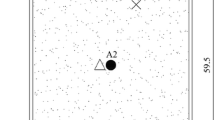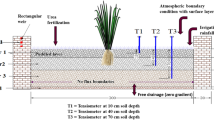Abstract
Efficient water and fertilizer use is of paramount importance both in rain-fed and irrigated rice cultivation systems to tread off between the crop water demand during the dry spell and the fertilizer leaching. This lysimeter study on paddy in a lateritic sandy loam soil of the eastern India, to simulate the water and solute transports using the HYDRUS-1D model, reveals that this model could very well simulate the soil depth-specific variations of water pressure heads and nitrogen (N) concentrations with the efficiency of >86 and 89%, respectively. The change in the level of water ponding depth did not have a significant effect on the time to peak and the temporal variability of N concentration in the bottom soil layer. The lysimeter-scale water balance analysis indicated that the average deep percolation loss and crop water use were 35.01 ± 2.03 and 39.74 ± 1.49% of the total water applied during the crop growth period, respectively. Similarly, the amount of N stored in the plant and lost through soil storage, deep percolation, and other losses (mineralization, denitrification, and gaseous N loss to the atmosphere through plant leaves) were 1.60 ± 0.16, 0.17 ± 0.04, 12.00 ± 0.48, and 86.23 ± 0.41% of the total applied nitrogen, respectively. The simulation results reveal that a constant ponding depth of 3 cm could be maintained in paddy fields to reduce the N leaching loss to 7.5 kgN/ha.








Similar content being viewed by others
References
Allen RG, Pereira LS, Raes D, Smith M (1998) Crop evapotranspiration Guidelines for computing crop water requirements. FAO, Irrigation and Drainage Paper, 56. FAO, Rome. pp 300
ASCE Task Committee on Irrigation and Drainage (1993) Criteria for evaluation of watershed models. Irrig Drain Eng ASCE 119(3):429–442
Azam F, Muller C, Weiske A, Benckise G, Ottow JCG (2002) Nitrification and denitrification as sources of atmospheric nitrous oxide: role of oxidizable carbon and applied nitrogen. Biol Fertil Soils 35:4–61
Bear J (1972) Dynamics of fluid in porous media. Elsevier, New York
Behera S, Panda RK (2006) Evaluation of management alterantives for an agricultural watershed in a sub-humid subtropical region using a physical process based model. Agric Ecosyst Environ 113:62–72
Belder P, Bouman BAM, Spiertz JHJ, Peng SB, Castañeda AR, Visperas R (2005) Crop performance, nitrogen and water use in flooded and aerobic rice. Plant Soil 273(1–2):167–182
Belmans C, Wesseling JG, Feddes RA (1983) Simulation of the water balance of cropped soil: SWATRE. J Hydrol 63:271–286
Bouman BAM, Tuong TP (2001) Field water management to save water and increase its productivity in irrigated lowland rice. Agric Water Manag 49:11–30
Bouman BAM, Hengsdijk H, Hardy B, Bindraban PS, Tuong TP, Ladha JK (2002) Water-wise rice production, Proc International Workshop on Water-wise rice production, 8–11 April 2002. Los Banos, Philippines
Bruckler L, de Cockborne AM, Renault P, Claudot B (1997) Spatial and temporal variability of nitrate in irrigated salad crops. Irrig Sci 17:53–61
Chen M, Willgoose GR, Saco PM (2012) Spatial prediction of temporal soil moisture dynamics using HYDRUS-1D. Hydrol Process 28(2):171–185
Choudhury ATMA, Kennedy IR (2005) Nitrogen fertilizer losses from rice soils and control of environmental pollution problems. Soil Sci Plant Anal 36:1625–1639
Dash CJ, Sarangi A, Singh DK, Singh AK, Adhikary PP (2014) Prediction of root zone water and nitrogen balance in an irrigated rice field using a simulation model. Paddy Water Environ. doi:10.1007/s10333-014-0439-x
FAO (Food and Agriculture Organization of the United Nations) (2008) Food Outlook Global Market Analysis, November Issue, Rome, Italy, 23–28
Feddes RA, Bresler E, Neuman SP (1974) Field test for a modified numerical model for water uptake by root systems. Water Resour Res 10:1199–1206
Feddes RA, Kowalik PJ, Zaradny H (1978) Simulation of field water use and crop yield. Jon Wiley and Sons, New York
Ginigaddara GAS, Ranamukhaarachchi SL (2009) Effect of conventional, SRI and modified water management on growth, yield and water productivity of direct-seeded and transplanted rice in central Thailand. Aust J Crop Sci 3(5):278–286
Guerra LC, Bhuyan SI, Tuong TP, Barker R (1998) Producing more rice with less water from irrigated systems. SWIM Paper 5 IWMI Colombo Sri Lanka
Hepburn JS (1908) The modifications of the Kjeldahl method for the quantitative determination of nitrogen. J Frankl Inst 166(2):81–89
IRRI (International Rice Research Institute) (2004) Annual Report. IRRI, Los Banos
Kiniry JR, Mccauley G, Xie Y, Arnold JG (2001) Rice parameters describing crop performance of four US cultivars. J Agron 93:1354–1361
Kosugi K (1996) Lognormal distribution model for unsaturated soil hydraulic properties. Water Resour Res 32(9):2697–2703
Li Y, Simunek J, Zhang Z, Jing L, Ni L (2015) Evaluation of nitrogen balance in a direct-seeded-rice field experiment using Hydrus-1D. Agric Water Manag 148:213–222
Marquardt DW (1963) An algorithm for least-squares estimation of nonlinear parameters. SIAM J Appl Math 11:431–441
Molz FJ, Remson I (1970) Extraction terms models of soil moisture use by transpiring plants. Water Resour Res 6:1346–1356
Mualem Y (1976) A new model for predicting the hydraulic conductivity of unsaturated porous media. Water Resour Res 12(3):513–522
Nash JE, Sutcliffe JV (1970) River flow forecasting through conceptual models, part I—A discussion of principles. J Hydrol 10:282–290
Phogat V, Malik RS, Kumar S (2009) Modeling the effect of canal bed elevation on seepage and water table rise in a sand box filled with loamy soil. Irrig Sci 27:191–200
Phogat V, Yadav AK, Malik R, Kumar S, Cox J (2010) Simulation of salt and water movement and estimation of water productivity of rice crop irrigated with saline water. Paddy Water Environ 8(4):333–346
Reeves TG, Waddington SR, Ortiz-Monasterio I, Banziger M, Cassaday K (2002) Removing nutritional limits to maize and wheat production: a developing country perspective. In: Kennedy IR, Choudhury ATMA (eds) Biofertilisers in action. Rural Industries Research and Development Corporation, Canberra, pp 11–36
Sahoo B (2013) Closure to: standardization of reference evapotranspiration models for a sub-humid valley rangeland in the Eastern Himalayas. J Irrig Drain Eng 139(9):795–796. doi:10.1061/(ASCE)IR.1943-4774.0000594
Sahoo B, Lohani AK, Sahu RK (2006) A fuzzy multiobjective and linear programming based management model for optimal land-water-plant system planning. Water Resour Manag 20(6):931–948. doi:10.1007/s11269-005-9015-x
Sahoo B, Walling I, Deka CB, Bhatt BP (2012) Standardization of reference evaporanspiration models for a sub-humid valley rangeland in the eastern Himalayas. J Irrig Drain Eng ASCE 138:880–895. doi:10.1061/(ASCE)IR.1943-4774.0000476
Schaap, MG, Leij, FJ, van Genuchten, MTh (1999) A bootstrap-neural network approach to predict soil hydraulic parameters. In: van Genuchten, MTh, Leij, FJ, Wu, L. (eds) Proceedings of international on workshop, characterization and measurements of the hydraulic properties of unsaturated porous media, pp 1237–1250, University of California, Riverside, CA
Sepaskhah AR, Tafteh A (2012) Application of HYDRUS-1D model for simulating water and nitrate leaching from continuous and alternate furrow irrigated rapeseed and maize fields. Agric Water Manag 113:19–29
Sharma PK (1989) Effect of period moisture stress on water use efficiency in wetland rice. Oryza 26:252–257
Šimůnek J, de Vos JA (1999) Inverse optimization, calibration and validation of simulation models at the field scale. Modelling of transport process in soils at various scales in time and space. In: J. Feyen, K. Wiyo, (eds) Proceedings of international workshop of EurAgEng’s field of interest on soil and water, Wageningen Pers, Wageningen, The Netherlands, pp 431–445
Simunek J, Sejna M, van Genuchten MTh (1998) The HYDRUS-1D software package for simulating water flow and solute transport in two-dimensional variably saturated media. Version 2.0. IGWMC-TPS-70. International Ground Water Modeling Center, Colorado School of Mines, Golden, CO
Simunek J, van Genuchten MTh, Sejna M (2005) The HYDRUS-1D software package for simulating the one-dimensional movement of water, heat, and multiple solutes in variably-saturated media Version-3.0, HYDRUS Software Series 1, Department of Environmental Sciences, University of California, Riverside, California, USA
Simunek J, van Genuchten MTh, Sejna M (2011) HYDRUS: model use, calibration and validation. Am Soc Agric Biol Eng ISSN 2151-0032, 55(4): 1261–1274
Šimůnek J, Köhne M, Kodešová R, Šejna M (2008) Simulating nonequilibrium movement of water, solutes and particles using HYDRUS–a review of recent applications. Soil Water Res 3:42–51
Šimůnek J, Šejna M, Saito H, Sakai M, van Genuchten MTh (2013) The HYDRUS-1D Software package for simulating the one-dimensional movement of water, heat, and multiple solutes in variably-saturated media, Version 4.16. Department of Environmental Sciences, University of California Riverside, Riverside, California, 23–24
Singh R, van Dam JC, Feddes RA (2005) Water productivity analysis of irrigated crops in Sirsa district, India. Agric Water Manag 82:253–278
Stephen RC, Waid JS (1963) Pot experiment on urea as a fertilizer, III. The influence of rate, form, time, and placement. Plant Soil 19:184–192
Sutanto SJ, Wenninger J, Coenders-Gerrits AMJ, Uhlenbrook S (2012) Partitioning of evaporation into transpiration, soil evaporation and interception: a comparison between isotope measurements and a Hydrus-1D model. Hydrol Earth Sys Sci 16(8):2605–2616
Tafteh A, Sepaskhah AR (2012) Application of HYDRUS-1D model for simulating water and nitrate leaching from continuous and alternate furrow irrigated rapeseed and maize fields. Agric Water Manag 113:19–29
Twarakavi NKC, Sakai M, Šimůnek J (2009) An objective analysis of the dynamic nature of field capacity. Water Resour Res 45:W10410. doi:10.1029/2009WR007944
Tyagi NK, Sharma DK, Luthra SK (2000) Determination of evapotranspiration and crop coefficient of rice and sunflower with lysimeter. Agric Water Manag 45:41–54
van Genuchten MTh (1980) A closed form equation for predicting the hydraulic conductivity of unsaturated soils. Soil Sci Soc Am J 44:882–898
Vogel T, Císlerová M (1988) On the reliability of unsaturated hydraulic conductivity calculated from the moisture retention curve. Transp Porous Media 3:1–15
Wang Q, Cameron K, Buchan G, Zhao L, Zhang EH, Smith N, Carrick S (2010) Comparison of lysimeters and porous ceramic cups for measuring nitrate leaching in different soil types. N Z J Agric Res 55:333–345
Wopereis MCS, Bouman BAM, Kropff MJ, Ten Berge HFM, Maligaya AR (1994) Water use efficiency of flooded rice fields I. Validation of the soil-water balance model SAWAH. Agric Water Manag 26(4):277–289
Xu J-Z, Peng S-Z, Hou H-J, Yang S-H, Luo Y-F, Wang W-G (2013) Gaseous losses of nitrogen by ammonia volatilization and nitrous oxide emissions from rice paddies with different irrigation management. Irrig Sci 31(5):983–994
Zuo H-J, Zhang Q, Ma L-Y, Zhai J-Q, Xu L-G (2010) Evaluation of soil water percolation in response to different rainfall conditions using HYDRUS-1D model in the low hill red soil region of Jiangxi, China. Soil Water Manag 1(3):76–84
Author information
Authors and Affiliations
Corresponding author
Rights and permissions
About this article
Cite this article
Jha, R.K., Sahoo, B. & Panda, R.K. Modeling the water and nitrogen transports in a soil–paddy–atmosphere system using HYDRUS-1D and lysimeter experiment. Paddy Water Environ 15, 831–846 (2017). https://doi.org/10.1007/s10333-017-0596-9
Received:
Revised:
Accepted:
Published:
Issue Date:
DOI: https://doi.org/10.1007/s10333-017-0596-9




